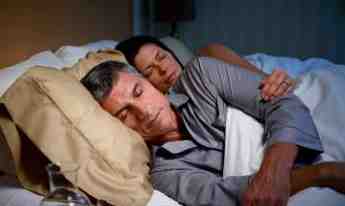OSA and hypersomnolence in patients with sarcoidosis is on the rise.

Other organs can be involved in sarcoidosis. They include peripheral lymph nodes, spleen, liver, mucous membranes, parotid glands, muscles, heart, and nervous system. The diagnosis usually can be made by clinical and imaging findings. Histological evidence of multiorgan, epithelioid-cell granulomas in the tissue, by excluding other known agents capable of causing similar granulomatous lesions, will confirm the diagnosis. Tuberculin test is usually negative and will help separate sarcoidosis from the diagnosis of tuberculosis. Steroid treatment is helpful to induce clinical remissions and suppress the inflammation and granuloma formation. Treatment of sarcoidosis may take many years to prevent clinical relapse.
An increased incidence of OSA in patients with sarcoidosis has been reported.2 The recent death of a football legend with both conditions has focused attention on the subject. Chronic fatigue has also been associated with or without OSA in patients with sarcoidosis.3-5 We report a representative patient with sarcoidosis who presented with chronic fatigue and central nervous system hypersomnolence with no evidence of sleep apnea.
A Case of Sarcoidosis
A 38-year-old black woman was followed in the neurology office for 8 years for idiopathic central nervous system hypersomnolence and sarcoidosis. The patient had a history of excessive daytime sleepiness and sleep paralysis. At the age of 19, she was diagnosed as having idiopathic central nervous system hypersomnolence. A nocturnal polysomnogram was performed and the following day was followed by a multiple sleep latency test (MSLT). The total recording time of NSPG was 425.5 minutes, total sleep time was 423 minutes, and the sleep latency was 0.5 minutes. During sleep, 23.2% was in stage I, 60.4% was in stage II, 7.2% was in stage III/IV, and 8.7% was in stage REM. The REM latency was 62.5 minutes. The mean sleep latency of the MSLT was 2.4 minutes, but there was no sleep onset REM period. This patient was treated with two tablets of methylphenidate at 10 mg in the morning and at night. She also had a ruptured cervical disc that most likely prevented her from having a good night’s sleep.
The patient had a chronic scaly rash in her right ear. A biopsy was done, and the rash was diagnostic for sarcoidosis (lupus pernio). The patient also had infrequent seizure-like activity during which her eyes briefly rolled upward. The patient complained of a neck ache, and myelopathic neurosarcoidosis was considered to be a possibility4; however, an MRI of the spinal cord was negative for abnormalities. Her neck pain could be explained by the presence of rupture of the intervertebral discs from C5-C7; therefore, steroid therapy was not started. Dextroamphetamine was added for the treatment of her sleepiness. Over the years, she had gained weight, which reached 280 pounds at 5 feet 8 inches. Her body mass index was 41. The patient continued to complain about her daytime sleepiness. On the Epworth Sleepiness Scale (ESS), she scored a 24 (over 10 is abnormal). The pulmonary function test suggested early small airway obstruction, and her lung volume was within normal limits. A mild decrease in pulmonary diffusing capacity to 75% of predicted values indicated loss of functioning alveolar-capillary membrane units. After administration of a bronchodilator, mid expiratory flow increased.
Chest x-rays were normal and showed no evidence of pulmonary sarcoidosis. A repeat overnight polysomnography test showed 51/2 hours of sleep. Sleep latency was 5.5 minutes, and sleep efficiency was 86.5%. REM latency was 222 minutes, and there was total curtailment of stage III/IV sleep; REM sleep was reduced to 12%.
Mild snoring was present and the apnea/hypopnea index was 0.6/hour. Arousal was not observed, and the periodic limb movement index was 6.5/hour, which was not associated with arousals. Oxygen nadir was at 93%; therefore, the patient did not have significant sleep-related breathing disorders.
Discussion
Sarcoidosis is frequently an incidental finding on a routine chest x-ray. The benign course of sarcoidosis is one of spontaneous remission over a period of 1 to 2 years with no evidence of disease and normal life span; however, there may be another type of sarcoidosis with progression. About 5% to 10% of cases may progress to an advanced pulmonary involvement. There are several factors that may contribute to an increased incidence of OSA in patients with sarcoidosis.6-8 The prolonged use of prednisone for treatment may lead to weight gain—enough to cause OSA. Involvement of the muscle at the pharynx could also lead to development of OSA. Sarcoidosis with granulomatous nodules may cause obstruction of the upper respiratory tract. Fortunately, it occurs in only 1% to 5% of the patients. Central sleep apnea may also develop in patients who have hypothalamic involvement. Lupus pernio is a form of sarcoid lesions involving the ears and the hands. The lesions resemble those of frostbite. This has been associated with upper respiratory tract involvement by sarcoid.9,10
Conclusion
A study of 83 patients with sarcoidosis by Turner and coworkers2 showed increased incidence of OSA in sarcoid patients as compared to their control group with other lung diseases; 17% of sarcoid patients were found to have sleep apnea vs only 3% of patients in the control group who had OSA. It was found that sleep apnea is even more frequent in the male sarcoid patients. Patients with lupus pernio lesions have more chance to have OSA. The ESS was very useful in identifying patients at risk for sleep apnea syndrome. The frostbite-like lesions involving the ears and hands may be a useful sign to diagnose OSA. The reason for this phenomenon may be due to the fact that approximately 50% of patients with lupus pernio have upper respiratory tract disease. In the most severe cases, upper airway obstruction may require treatment with prednisone, irradiation, and even tracheostomy. In mild cases, nasal CPAP would help.
In conclusion, according to the literature, patients with clinical sarcoidosis may have a significantly increased prevalence of OSA. It may present with severe fatigue and/or excessive daytime sleepiness. Many reasons for this have been presented, with male patients and patients with lupus pernio at higher risk; however, fatigue and hypersomnolence may occur in sarcoidosis without sleep apnea as well.
EDITOR’S NOTE: The references for this article are posted with the online version at www.sleepreviewmag.com.
Lawrence T. Chien, MD, FAAP, FAAN, ABSM, is clinical associate professor, University of Tennessee, Chattanooga.



